As the availability of hockey news and statistics continues to grow, fans have been able to track the progress of their team’s top prospects more efficiently. As a result, writers across the league release hundreds of numerical prospect rankings every year. While these articles tend to inspire healthy discussion, they don’t necessarily tell the entire story or give the reader an accurate perspective of how their team’s youngsters stack up against the rest of the league.
Sportsnet analyst, Steve Dangle has established a system that ranks prospects by tiers within a given organization while also charting their professional trajectory. The “Prospect Pyramid” as he calls it, has increased in popularity, becoming the new standard of sorting prospects. Dangle himself describes his system in depth in the video below, as it pertains to his team, the Toronto Maple Leafs.
St. Louis Blues staff writer, Stephen Ground originally introduced the idea at THW, and it has since taken off internally. For a team like the Buffalo Sabres, this system is particularly helpful given the current depth and talent level of the franchise prospect pool. Let’s take a look at what each tier of the pyramid represents, and how the Sabres of tomorrow stack-up.
Prospect Pyramid Explained
The concept is relatively simple. The pyramid is first split into six tiers. The very top is reserved for generational talent (spoiler alert: the Sabres have one of those). The second tier consists of players who have incredibly strong odds of either becoming top-six forwards, top-pairing defensemen, or starting goaltenders. It’s important to note that NHL-readiness is a factor here as well.
Here’s where things get interesting. Tier number three is for players who are either further out in their development than their tier two contemporaries, or for those who simply have a slightly lower projected ceiling. The distinction between tier two and tier three can be tricky, and it’s somewhat subjective to your own personal evaluation of a given player’s potential.
Residing in the fourth tier are players who project as league contributors. These are your middle-to-bottom-six forwards, bottom-four defensemen and fringe starter/talented backup goaltenders. Tier five is where things start to drop-off. These players may still have a chance to contribute at the NHL level, but their odds of eventually getting there in any meaningful capacity are markedly lower. Rounding out the pyramid is tier six, reserved for the remaining prospects who have a marginal chance of ever becoming big league regulars. Consider it a catch-all. We’ll use January 1, 1995 as the birthday cut-off for who qualifies as a “prospect” on our list.
Sabres Tier One: Rasmus Dahlin
Fortunately for the Sabres, they are one of the few teams in the NHL with a bonafide generational talent within the organization. After receiving some much-needed lottery luck in April, Buffalo was awarded the first-overall pick in the 2018 NHL Draft. With said pick, they made the easy choice in selecting Swedish blueliner, Rasmus Dahlin.
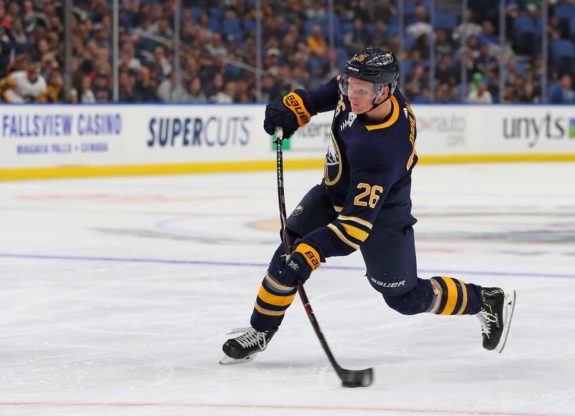
After setting the SHL ablaze with 20 points in 41 games for Frolunda last season, the 18-year-old defender became the consensus top draft-eligible prospect among amateur evaluators. Boasting elite puck-carrying ability and one-of-a-kind offensive prowess from the back-end, Dahlin figures to be a Norris Trophy candidate at some point in the not-too-distant future. It’s not an exaggeration. He’s that good.
It’s clear to see why he sits in a class of his own at the top of the list. Even though the Sabres do have a couple of high-octane forwards with incredibly high ceilings, nobody within the organization is as much of a sure bet. Though he will almost certainly go through some growing pains in his inaugural season, there isn’t a defensive prospect in the league with his ceiling.
Tier Two: Casey Mittelstadt
While there are one or two other prospects in the Sabres’ system who could garner consideration here, Mittelstadt is the only one who is a sure-fire top-six player moving forward. The reason he isn’t included in tier one is due to the fact that he isn’t considered “generational” by any stretch, but his odds of becoming one of the top centers in the NHL are quite good.
After being selected as the eighth overall pick of the 2017 NHL Draft, Mittelstadt took some heat on social media as photos of him failing to complete a chin-up at the Scouting Combine began to surface. Supporters of the blue-and-gold were nearly unanimous in their objection of the pick, however, his performance in collegiate action and on the world stage quickly changed the narrative surrounding the then 18-year-old.
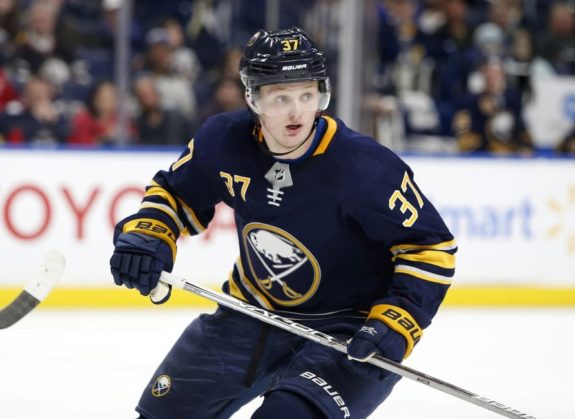
During his outstanding rookie campaign at the University of Minnesota, Mittelstadt received Most Valuable Player honors at the World Junior Championship in Buffalo where he posted 11 points in seven games for Team USA. Following the conclusion of his freshman season with the Golden Gophers, he signed his entry-level deal with the Sabres, appearing in the team’s final six games where he posted five points.
Despite struggling during preseason action leading up to the 2018-19 campaign, there is a very good chance that he starts the year in Buffalo. With the departure of Ryan O’Reilly via trade this summer, Mittelstadt figures to fill the second line center role behind franchise cornerstone, Jack Eichel.
Tier Three: Guhle, Nylander, Thompson
During the 18 games that Brendan Guhle spent with the Sabres last season, he was a breath of fresh air on arguably the league’s worst defensive corps. The two-way, possession-driving defenseman is a prototypical player for Phil Housley’s system. His ability to make passes in transition paired with an excellent set of wheels, project him as a top-four candidate moving forward.
Despite an elite skillset, Guhle still has some warts in his game. There are certainly times where his awareness in the defensive zone leaves something to be desired and he also has a tendency to be weak on the puck. Those are both fixable issues, but if he does indeed make the opening night roster, he’ll need to show improvement in these areas as the season progresses.
An argument can be made that Alex Nylander belongs in the second tier, but following two consecutive lackluster seasons in Rochester that were marred by injury and a widely-criticised lack of effort, he still has to prove worthy of his draft pedigree.
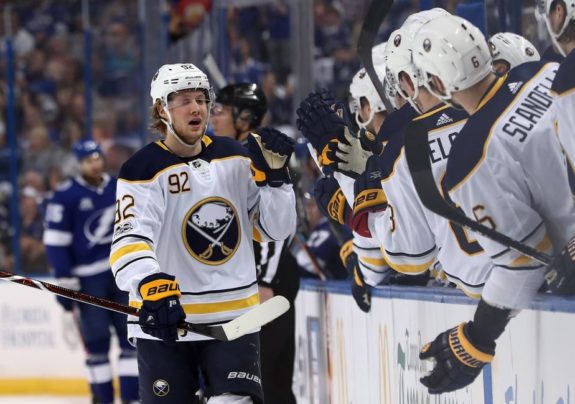
During training camp and the first few preseason contests that he’s appeared in, there is no question that he looks like a different player. When he first arrived at KeyBank Center earlier this month, media personnel were quick to point out his new and improved physique. Not only does he look the part, but his level of play has been particularly impressive. With three assists in four preseason games, he has been a major offensive catalyst.
If Nylander does indeed make the opening night roster, he could jump into tier two with a strong start to the 2018-19 season. For now, we’ll have to wait and see how well he is able to produce once the games actually count. The potential is sky-high, but until he shows marked strides in his development on a consistent basis, he cannot be considered a surefire top-six player in the NHL.
Rounding out the second tier is newcomer, Tage Thompson. In what was the blockbuster trade of the summer, the Sabres dealt veteran center, Ryan O’Reilly to the St. Louis Blues for Thompson, two draft picks and forwards Patrik Berglund and Vladimir Sobotka.
Initially, fans in Buffalo lamented the fact that Jason Botterill was unable to pry one of Jordan Kyrou or Robert Thomas from the Blues’ prospect pool, but after watching Thompson throughout preseason action, they’ve changed their tune. As one of the best performers on offense in the early going, the 20-year-old winger has had no trouble producing beside a variety of different linemates.
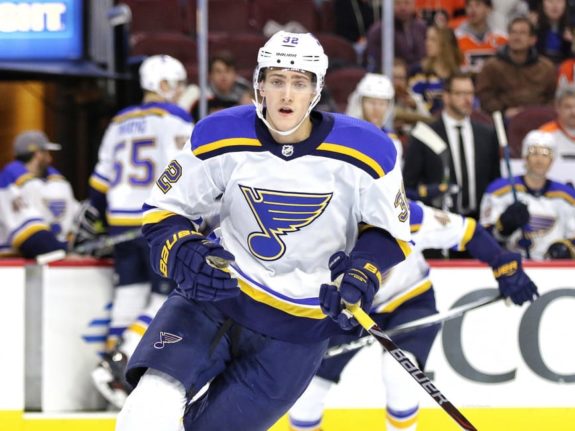
Using his impressive range and surprising skating ability for someone his size, Thompson has forced his way onto the Sabres roster after many prognosticators had him pegged for an AHL role. As a first-round pick in 2016, he has yet to reach his full potential, but the progress is certainly there. Should he continue his current trajectory, he will hammer out a top-six role with the blue-and-gold.
Related: Thompson is Ready for the Sabres Roster
Tier Four: Asplund, Borgen, Davidsson, Luukkonen, Olofsson, Pilut, Samuelsson
Oh how Swede it is. The fourth tier of the Buffalo prospect pyramid features five Swedish youngsters, all of whom are likely to contribute at the NHL level within the next few years.
As the prospect who arrived in the organization under the most interesting circumstances, Rasmus Asplund has quickly become a fan-favorite. In the second round of the 2016 NHL Draft, the Sabres traded up to the 33rd pick, dealing Mark Pysyk and also acquiring defenseman, Dmitri Kulikov. At first glance, fans were not fond of the deal, citing Pysyk’s superior Corsi statistics as the primary reason.
With the 33rd pick, the Sabres selected Asplund who was the wild card in analyzing which team “won” the trade. As his development has progressed, fans have certainly changed their tune. In three seasons with Farjestad BK of the SHL, the 20-year-old has posted 59 points in 135 games and served as an assistant captain in 2017-18.
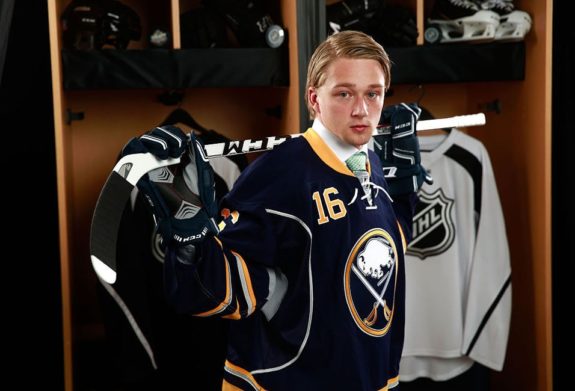
Fellow second-round pick, Marcus Davidsson has also produced nicely in the SHL. Last season with Djurgardens IF, he posted 21 points in 39 games. As a two-way forward who also brings a physical element to his game, his ceiling is likely a bit higher than some of the others in the fourth tier, however, he has a long way to go until he is ready for NHL action.
This season, he’ll spend another year in the SHL (where he has already produced three points in as many games). Next year he will likely make the jump to the AHL in what will be his first extended experience on North American ice.
Victor Olofsson has also made his mark in the Sabres pipeline as a natural goal-scorer. Last season he led the SHL in goals with 27 on the season en route to a 43 point campaign. In 2018-19 he will more than likely spend a majority of his time with the Rochester Americans of the AHL, but he will almost certainly see call-up time with the big club.
If the 23-year-old experiences a smooth transition to AHL action, he will prove to be one of the steals of the 2014 entry draft where he was selected by the Sabres with the 181st pick of the seventh round. There is a very real possibility that Olofsson can move up to tier three by this time next year.
Shifting gears toward the defense, Mattias Samuelsson is the youngest member of the fourth tier. As the first pick of the second round this year, he immediately helped restore what was a relatively empty prospect cupboard on the Buffalo blue line. With a physical, defensively responsible playing style, he projects as a top-four contributor moving forward.
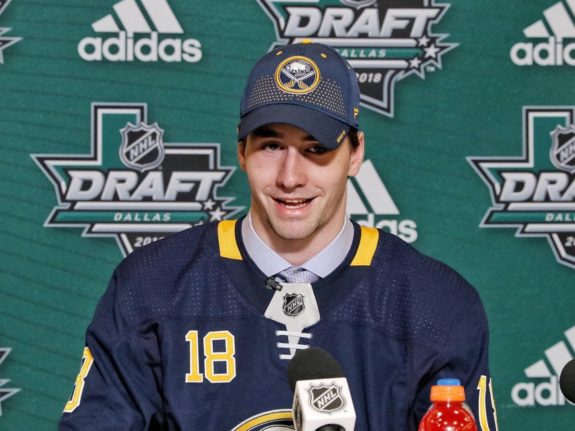
This season, he’ll play in the NCAA with the Western Michigan University Broncos. At 18 years old, he has some holes in his game that he will hope to shore up at the collegiate level.
On the opposite end of the NHL-readiness spectrum, Lawrence Pilut has quickly become a roster contender with the Sabres in 2018-19. In preseason action, he has been arguably the best blueliner on the team.
After being named as the SHL’s Most Outstanding Defenseman in 2017-18, Botterill was quick to sign the 22-year-old to an NHL contract. Leading up to training camp, it was widely considered a foregone conclusion that he would need to spend time in Rochester. As of right now, he has a very real chance of appearing in the Sabres’ top-six this season. If that’s the case, an argument can be made that he should be bumped up a tier.
American Olympian, Will Borgen squeaks in as a fourth tier player based primarily on the fact that he is one of the closest to being ready for an NHL role. Last year, he was the lone Sabres prospect representing Team USA at the 2018 Winter Olympics. In three seasons with St. Cloud State, he earned a reputation as an elite defender, earning Defensive Defenseman of the Year honors in the NCHC conference.
This season he will suit up for the Amerks, but don’t expect him to be there for long. His ability as a puck mover who also displays outstanding competence in his own end will prove useful for a Buffalo team who has struggled in transition over the last few years.
In between the pipes is Finnish goaltending prospect, Ukko Pekka Luukkonen. As the top young netminder in the organization, the Sabres have placed their faith in him to one day become the team’s franchise goalie.
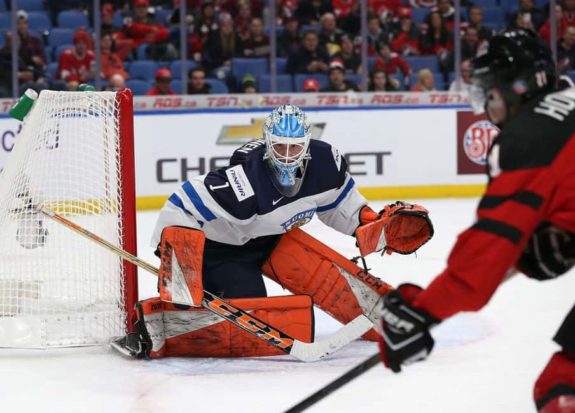
After spending last season in the Finnish B-League, Mestis, he will transition to North American play in 2018-19 after being selected in the OHL transfer draft by the Sudbury Wolves. This will be a critical development year for Luukkonen. If he produces impressive numbers with the Wolves, there is a very real chance he could suit up for the Amerks next season given their relatively weak situation in net.
Related: Ranking Sabres Prospects Before the Draft
Tier Five: Bryson, Fitzgerald, Hickey, Laaksonen, Ogilvie, Pekar, Weissbach
Most of the prospects in tier five are either far away in their professional development or have a very small chance of ever becoming anything more than a depth player in the NHL. That’s not to say that there is no upward mobility, but they all have something to prove in order to advance in the rankings this time next year.
The Sabres’ fifth tier consists of mostly collegiate skaters with a few minor leaguers and junior players sprinkled in. Boston College captian, Casey Fitzgerald is a prime example of how the organization has emphasized player development in the NCAA. Now entering his fourth season at BC, fans have grown somewhat uneasy considering the fact that he has yet to be signed to an ELC. If he has a strong season in 2018-19, he could elect to become an unrestricted free agent, especially given the Sabres newfound depth organizationally on the back end.
One of Fitzgerald’s cross-town rivals signed a two-year entry-level deal with the Sabres this summer after coming over via trade from the Arizona Coyotes. Buffalo received Boston University captain, Brandon Hickey and AHL veteran Mike Sislo in exchange for forward Hudson Fasching. A defensively focused blueliner who can also contribute offensively, Hickey finished his senior year with the Terriers, registering 14 points in 38 games. At 22 years old, he’ll suit up for the Amerks this season.
The results of putting Jordan Greenway in the center of the ice as a center. His size and strength help set up Brandon Hickey for the eventual goal. 2-1 BU early 3rd. pic.twitter.com/XyDtyrTqTA
— BucciOT.Com (@Buccigross) February 6, 2018
Staying in the New England region, Providence University defenseman and alternate captain, Jacob Bryson is one of the new-wave undersized blueliners who specialize in executing offensive transition. At just 5-foot-9, 175-pounds, the former fourth-round pick has shown improvement at both ends of the ice. His continued development as a junior this season will determine if the team extends him a professional contract next summer.
Shifting our focus across the pond, Oskari Laaksonen, one of the biggest “boom-or-bust” prospects in the Sabres system, will suit up for his second professional season with Ilves of the Finnish Liiga. As a slender, rangy player on the back-end, he will look to add muscle to his 6-foot-2, 165-pound frame.
After Laaksonen was selected by Buffalo in the third round of the 2017 draft, fans were left scratching their heads. Very few people had heard of him, and he was seen as somewhat of an “off-the-board” pick. His development as an offensive catalyst is already evident in his first five games with Ilves this season where his four points thus far have already matched his 21-game output from 2017-18.
At forward, the Sabres continued their hunt for collegiate standouts this summer, acquiring free agent Andrew Oglevie, a Notre Dame product. Last season he scored at over a point-per-game pace for the second consecutive season and was named to the NCAA All-Tournament Team.
This season he will spend time with Rochester in a presumed top-six role. If he is able to bring his offensive acumen to the professional ranks, there is a very good chance that he will receive a call-up with the Sabres at some point this year.
One of the most exciting players to watch in tier five is Czech forward, Matej Pekar. As the only forward selected by the Sabres in the 2018 draft, he caught fans’ attention during prospect camp last month, exhibiting playmaking ability and physicality. He even managed to get under the skin of a certain franchise defenseman. This year he will suit up for the Barrie Colts of the OHL.
Matej Pekar: “I love to be the annoying guy, getting under other guys’ skin. It’s my game.”
Says no hard feelings after hit from Dahlin yesterday: “That guy’s great.“ pic.twitter.com/TFJTeFjsud
— Buffalo Sabres (@BuffaloSabres) June 30, 2018
Rounding out the tier five forward group is, you guessed it, another Swedish prospect. Linus Weissbach fits the organizational profile two-fold, both as a product of Sweden, and a collegiate player in the NCAA.
In his freshman year with the University of Wisconsin last season, he was an offensive powerhouse, posting 26 points in 34 games for the Badgers. Using his nose for the net and ability to thread the needle, his versatility will be a huge asset moving forward. Similar to Laaksonen, he is very much a boom-or-bust prospect at this point in his development, but his growth since being selected in the seventh round last year is quite intriguing.
Tier Six: The Remainder
Finally, we’ve reached the bottom of the prospect pyramid. The Sabres have a pretty interesting mix of elder prospects with little hope of ever earning playing time in the big league and a few relatively unknown players who were recently selected in the 2018 draft.
Of those who would need to do something spectacular to resurrect their NHL hopes are players like Devante Stephens, Christopher Brown, Vaclav Karabacek, Eric Cornel, Ivan Chukarov, Brett Murray, and Vasily Glotov.
Stephens, Cornel and Glotov will all hope to make the Amerks’ roster this year, otherwise, they’ll have to spend time in the ECHL with the Cincinnati Cyclones. Brown regressed last season as a junior at Boston College and will head back for his senior season in 2018-19. Chukarov will also play out his senior season in the NCAA this year with UMass-Amherst. Barring something unforeseen, this year will likely be the last in the Sabres organization for many (if not all) of these prospects.
Recent late-round draft picks Linus Lindstrand-Kronholm, Miska Kukkonen, and William Worge Kreu are all far too early in their respective development to place any higher on the list.